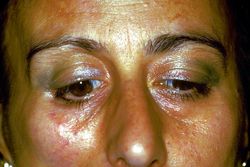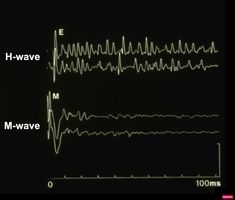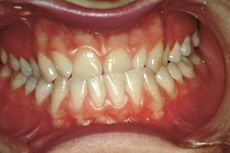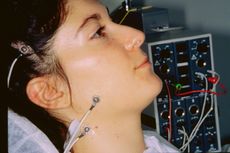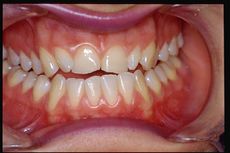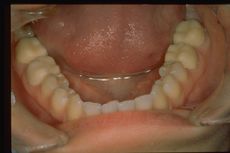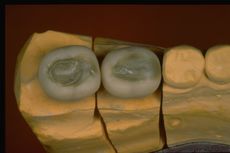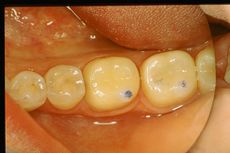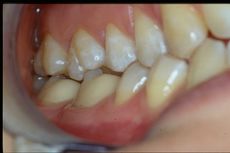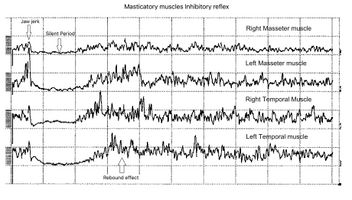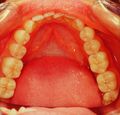Difference between revisions of "4° Klinischer Fall: Kiefergelenkserkrankungen"
| Line 23: | Line 23: | ||
</gallery> | </gallery> | ||
</center> | </center> | ||
Magda Krasińska-Mazur et al.<ref>Magda Krasińska-Mazur, Paulina Homel, Andrzej Gala, Justyna Stradomska, Małgorzata Pihut. Differential diagnosis of temporomandibular disorders - a review of the literature.Folia Med Cracov. 2022;62(2):121-137. doi: 10.24425/fmc.2022.141703.</ref> sagt zu Recht, dass die richtige Diagnose von Kiefergelenkserkrankungen auf Anamnese und gründlicher körperlicher Untersuchung sowie den Ergebnissen zusätzlicher Tests beruht... aber welche? | |||
=== | {{q2|Was könnte der beste Ansatz für Patienten mit TMDs sein?|......Wir werden in diesem Zusammenhang ein diagnostisches Modell vorstellen, das darauf abzielt, den funktionalen Kauzustand des betroffenen Patienten wiederherzustellen.}}Bisher haben wir viele Aspekte diskutiert, die auf die eine oder andere Weise die differenzierte Diagnose bei Patienten verzögern, die eine überlappende Symptomatik und verschiedene klinische Manifestationen aufweisen. Eine differenzierte Diagnose, die jedoch korrekt und schnell durchgeführt wird, könnte dem betreffenden Subjekt das Leben retten, wie es unserem 'Bruxer' passiert ist, leider aber nicht unserem 'Balancer'. Die Denkweise des Arztes ist in diesen Fällen grundlegend, und das entscheidende Element bleibt das Heraustreten aus dem 'spezialistischen Kontext', um gleichzeitig eine indeterministische und probabilistische Sichtweise der Medizin einzunehmen. Dies gilt auch für Patienten, die tatsächlich unter TMDs leiden, da es keine echte neurognathologische Disziplin gibt. Die Diagnose sowie die Therapie dieser Personen bleibt die Standardmethode, nämlich die gnathologische. Die Disziplin der Gnathologie, obwohl sehr valide, ist auch begrenzt, da sie das Feld des 'Beobachtbaren' auf den okklusalen Parameter einschränkt und alles andere außer Acht lässt, was Teil des neuromotorischen Kausystems und darüber hinausgehend ist.<ref>Chiara Vompi, Emanuela Serritella, Gabriella Galluccio, Santino Pistella, Alessandro Segnalini, Luca Giannelli, Carlo Di Paolo. Evaluation of Vision in Gnathological and Orthodontic Patients with Temporomandibular Disorders: A Prospective Experimental Observational Cohort Study. J Int Soc Prev Community Dent PMID: 33042891 PMCID: PMC7523923 DOI: 10.4103/jispcd.JISPCD_273_19</ref> Wir werden diesen klinischen Fall eines Patienten mit TMDs vorstellen, um eine signifikante klinische diagnostische/therapeutische Veränderung im Bereich der 'Funktionalen Neurognathologie' vorzustellen und sie genau als die NGF-Methode zu bezeichnen. | ||
=== Anamnese === | |||
[[File:Clicker 00.jpg|thumb|'''Figure 2:''' Oral situation of the patient affected by TMDs showing the ant erior cross bite]] | [[File:Clicker 00.jpg|thumb|'''Figure 2:''' Oral situation of the patient affected by TMDs showing the ant erior cross bite]] | ||
Wie üblich haben wir unsere Patientin mit einem ausgefallenen Namen, genau genommen "Clicker", bezeichnet, weil die Patientin seit Jahren unter Klickgeräuschen im Kiefergelenk (TMJ) litt. Clicker stellte sich in unserer neuropathologischen Abteilung vor und klagte über starke orofaziale Schmerzen sowie über eine chronische Entfernung des rechten TMJ-Gelenks. Sie kam, nachdem sie bereits nach dem RDC-Protokoll als DTM diagnostiziert worden war und nur mit einer Beißschiene behandelt worden war, um das nächtliche Zähneknirschen zu kontrollieren. Sie, eine 40-jährige Patientin, berichtete von orofazialen Schmerzen mit Gelenkgeräuschen wie Klicks und Knallen auf beiden Seiten des Gesichts sowie Schwierigkeiten beim Kauen. | |||
Eine erste klinische okklusale Untersuchung zeigt eine funktionelle okklusale Klasse III mit Gleiten in Vorwärtsbewegung bis zur maximalen Interkuspidation. Bei der Palpation waren die Masseter, die Schläfenmuskeln und die äußeren Flügelmuskeln auf beiden Seiten empfindlich. Keine Gleichgewichts- oder Gangstörungen, kein Schwindel, kein Tinnitus, aber wie in unserer Routine führten wir sofort trigeminale elektrophysiologische Tests durch, um jegliche strukturelle Beteiligung des trigeminalen zentralen Nervensystems (tNCS) auszuschließen. Wie bereits im Kapitel über den Patienten 'Balancer' mit Meningiom erklärt, bei dem die Interferenz-EMG-Untersuchung durch die zahnmedizinischen Kollegen keine Hinweise auf eine organische Pathologie des tNCS in unserem Diagnostikzentrum ergab, führen wir nur evozierte Potenziale und die Batterie trigeminaler Reflexe durch. In diesem Kapitel haben wir aufgrund der klinischen Situation den rein zahnärztlichen Kontext umgangen, da nach einer ersten objektiven Untersuchung die malokklusive Störung auffällig, aber nicht sicher ist (Abbildung 2). | |||
[[File:Clicker 01.jpg|thumb|alt=|left|615x615px|'''Figure 3:''' Neurognathological Functional electrophysiological tests]] | [[File:Clicker 01.jpg|thumb|alt=|left|615x615px|'''Figure 3:''' Neurognathological Functional electrophysiological tests]] | ||
==== | ==== Trigeminale Elektrophysiologie ==== | ||
Wie in den vorherigen Kapiteln von Masticationpedia dokumentiert wurde, liegt das Herz der wissenschaftlichen Philosophie von Masticationpedia im Wesentlichen in der Normalisierung der Kaukraft auf das zentrale Nervensystem und das periphere trigeminale tCNS und nicht auf der zahnärztlichen Okklusion. Dies ermöglicht es, die okklusale Abnormalität mit den 'Zustands' des <sub>t</sub>CNS zu verknüpfen, wie dies im ersten Kapitel '[[Einführung]]' ausführlich dokumentiert ist, in dem wir eine perfekte trigeminale elektrophysiologische Symmetrie bei einer Person mit schwerer zahnärztlicher Malokklusion und eine deutlich asymmetrische neuromotorische Situation bei einer Person mit perfekter Okklusion nach der Behandlung mit kieferchirurgischen Eingriffen gezeigt haben. Die elektrophysiologischen Tests bei Personen mit TMDs beschränken sich auf die bilateralen motorisch evozierten Potenziale der trigeminalen Wurzeln, die wir im Laufe der Jahre genau als <sub>b</sub>Root-MEPs<ref name=":1">Frisardi G. The use of transcranial stimulation in the fabrication of an occlusal splint.J Prosthet Dent. 1992 Aug;68(2):355-60. doi: 10.1016/0022-3913(92)90345-b.PMID: 1501190</ref> bezeichnet haben, ausgehend von der Kieferreflexprüfung in Ruheposition<ref name=":2">Cruccu G, Frisardi G, van Steenberghe D. Side asymmetry of the jaw jerk in human craniomandibular dysfunction. Arch Oral Biol. 1992 Apr;37(4):257-62. doi: 10.1016/0003-9969(92)90047-c.PMID: 1520092</ref> (Kieferreflex in Ruheposition) und der Kieferreflexprüfung in geschlossener Stellung mit mäßiger Muskelaktivität (Kieferreflex in Okklusalposition). | |||
===== <sub>b</sub>Root-MEPs ===== | ===== <sub>b</sub>Root-MEPs ===== | ||
In | In Abbildung 3 können wir die Reaktionen der motorisch evozierten Potenziale der beiden trigeminalen Wurzeln sehen, den Kieferreflex in Ruheposition und in der Position der maximalen Interkuspidation. Insbesondere reagiert das Nervensystem auf die transkranielle elektrische Stimulation der trigeminalen Wurzeln mit zwei evozierten Potenzialen, die sowohl in Latenz als auch in Amplitude perfekt symmetrisch sind. Die Latenzen liegen bei einem Beginn von <math>1R= 2,01</math> ms und <math>1L= 1,99 </math> ms, während die Peak-to-Peak-Amplituden <math>2R-3R= 5</math>mV und <math>2L-3L= 5,2</math>mV betragen. Dieses Ergebnis ist für die differenzielle Diagnose zwischen organischen und funktionellen Pathologien entscheidend, da es zeigt, dass das System organisch symmetrisch und synchron ist. Dies bestimmt den Begriff, der in den folgenden Kapiteln von Masticationpedia entscheidend wieder auftauchen wird, nämlich die "Organische Symmetrie". Beachten Sie bereits jetzt, dass der Parameter der "Organischen Symmetrie" als ein Element der "Normalisierung" der trigeminalen Reflexantworten betrachtet wird, da seine Latenz- und Amplitudensymmetrie auf einen perfekten "Zustand" der Integrität des <sub>t</sub>CNS hinweist. Gleichzeitig sollte man einen ebenso perfekten "Zustand" der funktionellen Symmetrie aufgrund der trigeminalen Reflexantworten erwarten. Lassen Sie uns daher den trigeminalen funktionellen "Zustand" des <sub>t</sub>CNS analysieren, indem wir den Kieferreflex | ||
===== | ===== Der Kieferreflex in Ruheposition ===== | ||
Der Dehnreflex-Test namens Kieferreflex wurde in Ruheposition durchgeführt, um die Eingangskomponente zum <sub>t</sub>CNS zu unterscheiden und den Input der Periodontalrezeptoren auszuschließen. Die Ergebnisse waren nicht ermutigend aufgrund der relativen Asymmetrie der Latenz (<math>1R= 8,5</math>ms und <math>1L= 7,5</math>ms) und der Peak-to-Peak-Amplitude (<math>2R-3R= 0,3 | |||
</math>mV; <math>2L-3L= 0,6</math>mV). | </math> mV; <math>2L-3L= 0,6</math> mV). Insbesondere könnte die Latenzverzögerung durch eine Erleichterung der Gamma-Motorneuronen erklärt werden, im Gegensatz zu der Studie von Kitagawa et al.,<ref>Kitagawa Y, Enomoto S, Nakamura Y, Hashimoto K. Asymmetry in jaw-jerk reflex latency in craniomandibular dysfunction patients with unilateral masseter pain. J Oral Rehabil. 2000 Oct;27(10):902-10. doi: 10.1046/j.1365-2842.2000.00595.x.PMID: 11065026</ref> in der behauptet wird, dass die Erleichterung auf der ipsilateralen Seite durch eine Verstärkung der Gamma-Antriebsfunktion induziert durch eine prolongierte nozizeptive Stimulation produziert werden könnte. In unserem Fall ist das signifikanteste Datum der Unterschied von <math>\simeq 50%</math> mit einer Reduktion auf der betroffenen rechten Seite. Wir haben in unseren Studien festgestellt, dass der Kieferreflex in Ruheposition auch von der Beschleunigung des Auslöseschlags abhängt, sondern auch von der räumlichen Position des Kiefers, da er nicht von der okklusalen Position beeinflusst wird.<ref name=":2" /> | ||
===== | ===== Der Kieferreflex in Zentrikposition ===== | ||
The jaw jerk, keeping the mandible in a position of centric occlusion, performed to verify the contribution of the periodontal receptors together with the muscle and tendon proprioceptors, was obviously facilitated by the dental contact but the asymmetry in amplitude (<math>2R-3R= 0, 1 | The jaw jerk, keeping the mandible in a position of centric occlusion, performed to verify the contribution of the periodontal receptors together with the muscle and tendon proprioceptors, was obviously facilitated by the dental contact but the asymmetry in amplitude (<math>2R-3R= 0, 1 | ||
</math>mV; <math>2L-3L= 1</math> mV) increased. This result agrees with what was stated in a study by Yoshino T et al.<ref>Yoshino T.Kokubyo Gakkai Zasshi. Effects of lateral mandibular deviation on masseter muscle activity. 1996 Mar;63(1):70-87. doi: 10.5357/koubyou.63.70.PMID: 8725358 </ref> in which the mandibular position was deviated by 0.5, 1.0, 1.5, 2.0 and 3.0 mm to the right and left from a reference position corresponding to the rest position. Jaw jerk amplitude on the mediotrusive side increased primarily in proportion to mandibular deviation. The study concludes by suggesting that jaw jerk may aid the clinical examination of minor mandibular deviations. The conclusion of this 1st trigeminal electrophysiological step was to ascertain the organic integrity of the <sub>t</sub>CNS through the symmetry and synchronics of the <sub>b</sub>Root-MEPs,<ref name=":1" /> and consider it as an 'Organic Symmetry',<ref>G Frisardi, G Chessa, A Lumbau, S Okkesim, B Akdemir, S Kara, F.Frisardi. The Reliability of the Bilateral Trigeminal Roots-motor Evoked Potentials as an Organic Normalization Factor: Symmetry or Not Symmetry. Dentistry S2 8, [tel:2161-1122 2161-1122]</ref> i.e. normalizer of the masticatory neurophysiological process while the asymmetries of the jaw jerk a functional disorder due to an unbalanced peripheral input or an inhibitory process on the trigeminal motoneurons of the nociceptive type. In essence, the conclusion of a mandibular spatial disorder would seem more indicative, which we will ascertain later when the Neuro Evoked Centric Relationship is performed to verify the physiological spatial position. | </math>mV; <math>2L-3L= 1</math> mV) increased. This result agrees with what was stated in a study by Yoshino T et al.<ref>Yoshino T.Kokubyo Gakkai Zasshi. Effects of lateral mandibular deviation on masseter muscle activity. 1996 Mar;63(1):70-87. doi: 10.5357/koubyou.63.70.PMID: 8725358 </ref> in which the mandibular position was deviated by 0.5, 1.0, 1.5, 2.0 and 3.0 mm to the right and left from a reference position corresponding to the rest position. Jaw jerk amplitude on the mediotrusive side increased primarily in proportion to mandibular deviation. The study concludes by suggesting that jaw jerk may aid the clinical examination of minor mandibular deviations. The conclusion of this 1st trigeminal electrophysiological step was to ascertain the organic integrity of the <sub>t</sub>CNS through the symmetry and synchronics of the <sub>b</sub>Root-MEPs,<ref name=":1" /> and consider it as an 'Organic Symmetry',<ref>G Frisardi, G Chessa, A Lumbau, S Okkesim, B Akdemir, S Kara, F.Frisardi. The Reliability of the Bilateral Trigeminal Roots-motor Evoked Potentials as an Organic Normalization Factor: Symmetry or Not Symmetry. Dentistry S2 8, [tel:2161-1122 2161-1122]</ref> i.e. normalizer of the masticatory neurophysiological process while the asymmetries of the jaw jerk a functional disorder due to an unbalanced peripheral input or an inhibitory process on the trigeminal motoneurons of the nociceptive type. In essence, the conclusion of a mandibular spatial disorder would seem more indicative, which we will ascertain later when the Neuro Evoked Centric Relationship is performed to verify the physiological spatial position. | ||
Revision as of 18:57, 15 March 2024
4° Klinischer Fall: Kiefergelenkserkrankungen
Zusammenfassung
Im Kapitel 'Einleitung' haben wir einen demonstrativen klinischen Fall vorgestellt, der das Konzept der 'Malokklusion' herausforderte, indem dargelegt wurde, dass jede Klasse oder okklusale Morphologie immer mit trigeminalen neuromotorischen Reaktionen verbunden sein sollte, um das Vorhandensein einer kieferorthopädischen pathologischen Störung zu bestätigen. In diesem Fall wurde festgestellt, dass das Subjekt eine perfekte Symmetrie in Latenz, Amplitude und integralen Bereichen des trigeminalen Zentralnervensystems (tCNS) aufwies und daher kaum als 'Malokklusion' klassifiziert werden konnte. Es sollte jedoch beachtet werden, dass das betreffende Subjekt mit offensichtlicher okklusaler Anomalie absolut keine Kaustörung hatte. Aber was passiert bei einem ähnlichen Subjekt, das über orofaziale Schmerzen und Gelenkstörungen berichtet? In diesem Kapitel werden wir sehen, wie ein solcher Patient betrachtet werden sollte, und wir werden mit einer Darstellung der Schritte abschließen, die für die prothetische Rehabilitation mit einer trigeminalen elektrophysiologischen Methode namens 'NGF-Modell' durchgeführt wurden, das im Laufe der Masticationpedia-Ausgabe in ein diagnostisches Modell namens 'Index ' umgewandelt wird.
Einführung
Ein Artikel von Ahmad und Schiffman[1] enthüllte interessante Elemente, die eine eingehendere Analyse des TMD-Phänomens erfordern. Die Autoren berichteten nämlich, dass etwa 5-12% der US-Bevölkerung von TMD betroffen sind und die jährlichen Kosten für das Management von TMD, ohne Bildgebungskosten, etwa 4 Milliarden US-Dollar betragen. In einer Umfrage des National Health Interview Survey (NHIS), an der insgesamt 189.977 Personen teilnahmen, hatten 4,6% (n = 8964) temporomandibuläre Gelenk- und Muskelerkrankungen (TMJD).
Wie wir bereits mehrmals in den vorherigen Kapiteln erwähnt haben, ist eines der kritischen Elemente in der Differentialdiagnose zwischen Orofazialschmerzen und TMD das Auftretensdatum der Erkrankung, das zwangsläufig das Ergebnis des Vorhersagewerts des Bayes-Theorems verfälscht. In diesem Fall, basierend auf den Überlegungen der Autoren,[1] liegen wir bei 4,6 Prozent.
Wir wissen inzwischen, dass 'TMD' die zweithäufigste chronische muskuloskeletale Erkrankung nach chronischen Rückenschmerzen ist,[2] und obwohl Ahmad und Schiffman[1] ausführlich über die Bedeutung der Bildgebung zur korrekten intraartikulären Diagnose des Kiefergelenks berichtet haben, entsteht Zweifel an der Überlappung von symptomatischen klinischen Zuständen, wie wir sie in den klinischen Fällen gesehen haben, die in den vorherigen Kapiteln von Masticationpedia berichtet wurden.
Diese Störung hängt nicht von der Fähigkeit des Arztes ab, sondern von der deterministischen Forma mentis, die keinen Raum für das Phänomen der überlappenden Pathologien lässt, die die gleiche TMD-Symptomatik simulieren. Ein schneller Überblick über die klinischen Fälle, die in den Kapiteln von Masticationpedia berichtet wurden, kann uns besser an die Komplexität und Wahrhaftigkeit dieser Aussage erinnern. (Abbildung 1)
Magda Krasińska-Mazur et al.[3] sagt zu Recht, dass die richtige Diagnose von Kiefergelenkserkrankungen auf Anamnese und gründlicher körperlicher Untersuchung sowie den Ergebnissen zusätzlicher Tests beruht... aber welche?
(......Wir werden in diesem Zusammenhang ein diagnostisches Modell vorstellen, das darauf abzielt, den funktionalen Kauzustand des betroffenen Patienten wiederherzustellen.)
Bisher haben wir viele Aspekte diskutiert, die auf die eine oder andere Weise die differenzierte Diagnose bei Patienten verzögern, die eine überlappende Symptomatik und verschiedene klinische Manifestationen aufweisen. Eine differenzierte Diagnose, die jedoch korrekt und schnell durchgeführt wird, könnte dem betreffenden Subjekt das Leben retten, wie es unserem 'Bruxer' passiert ist, leider aber nicht unserem 'Balancer'. Die Denkweise des Arztes ist in diesen Fällen grundlegend, und das entscheidende Element bleibt das Heraustreten aus dem 'spezialistischen Kontext', um gleichzeitig eine indeterministische und probabilistische Sichtweise der Medizin einzunehmen. Dies gilt auch für Patienten, die tatsächlich unter TMDs leiden, da es keine echte neurognathologische Disziplin gibt. Die Diagnose sowie die Therapie dieser Personen bleibt die Standardmethode, nämlich die gnathologische. Die Disziplin der Gnathologie, obwohl sehr valide, ist auch begrenzt, da sie das Feld des 'Beobachtbaren' auf den okklusalen Parameter einschränkt und alles andere außer Acht lässt, was Teil des neuromotorischen Kausystems und darüber hinausgehend ist.[4] Wir werden diesen klinischen Fall eines Patienten mit TMDs vorstellen, um eine signifikante klinische diagnostische/therapeutische Veränderung im Bereich der 'Funktionalen Neurognathologie' vorzustellen und sie genau als die NGF-Methode zu bezeichnen.
Anamnese
Wie üblich haben wir unsere Patientin mit einem ausgefallenen Namen, genau genommen "Clicker", bezeichnet, weil die Patientin seit Jahren unter Klickgeräuschen im Kiefergelenk (TMJ) litt. Clicker stellte sich in unserer neuropathologischen Abteilung vor und klagte über starke orofaziale Schmerzen sowie über eine chronische Entfernung des rechten TMJ-Gelenks. Sie kam, nachdem sie bereits nach dem RDC-Protokoll als DTM diagnostiziert worden war und nur mit einer Beißschiene behandelt worden war, um das nächtliche Zähneknirschen zu kontrollieren. Sie, eine 40-jährige Patientin, berichtete von orofazialen Schmerzen mit Gelenkgeräuschen wie Klicks und Knallen auf beiden Seiten des Gesichts sowie Schwierigkeiten beim Kauen.
Eine erste klinische okklusale Untersuchung zeigt eine funktionelle okklusale Klasse III mit Gleiten in Vorwärtsbewegung bis zur maximalen Interkuspidation. Bei der Palpation waren die Masseter, die Schläfenmuskeln und die äußeren Flügelmuskeln auf beiden Seiten empfindlich. Keine Gleichgewichts- oder Gangstörungen, kein Schwindel, kein Tinnitus, aber wie in unserer Routine führten wir sofort trigeminale elektrophysiologische Tests durch, um jegliche strukturelle Beteiligung des trigeminalen zentralen Nervensystems (tNCS) auszuschließen. Wie bereits im Kapitel über den Patienten 'Balancer' mit Meningiom erklärt, bei dem die Interferenz-EMG-Untersuchung durch die zahnmedizinischen Kollegen keine Hinweise auf eine organische Pathologie des tNCS in unserem Diagnostikzentrum ergab, führen wir nur evozierte Potenziale und die Batterie trigeminaler Reflexe durch. In diesem Kapitel haben wir aufgrund der klinischen Situation den rein zahnärztlichen Kontext umgangen, da nach einer ersten objektiven Untersuchung die malokklusive Störung auffällig, aber nicht sicher ist (Abbildung 2).
Trigeminale Elektrophysiologie
Wie in den vorherigen Kapiteln von Masticationpedia dokumentiert wurde, liegt das Herz der wissenschaftlichen Philosophie von Masticationpedia im Wesentlichen in der Normalisierung der Kaukraft auf das zentrale Nervensystem und das periphere trigeminale tCNS und nicht auf der zahnärztlichen Okklusion. Dies ermöglicht es, die okklusale Abnormalität mit den 'Zustands' des tCNS zu verknüpfen, wie dies im ersten Kapitel 'Einführung' ausführlich dokumentiert ist, in dem wir eine perfekte trigeminale elektrophysiologische Symmetrie bei einer Person mit schwerer zahnärztlicher Malokklusion und eine deutlich asymmetrische neuromotorische Situation bei einer Person mit perfekter Okklusion nach der Behandlung mit kieferchirurgischen Eingriffen gezeigt haben. Die elektrophysiologischen Tests bei Personen mit TMDs beschränken sich auf die bilateralen motorisch evozierten Potenziale der trigeminalen Wurzeln, die wir im Laufe der Jahre genau als bRoot-MEPs[5] bezeichnet haben, ausgehend von der Kieferreflexprüfung in Ruheposition[6] (Kieferreflex in Ruheposition) und der Kieferreflexprüfung in geschlossener Stellung mit mäßiger Muskelaktivität (Kieferreflex in Okklusalposition).
bRoot-MEPs
In Abbildung 3 können wir die Reaktionen der motorisch evozierten Potenziale der beiden trigeminalen Wurzeln sehen, den Kieferreflex in Ruheposition und in der Position der maximalen Interkuspidation. Insbesondere reagiert das Nervensystem auf die transkranielle elektrische Stimulation der trigeminalen Wurzeln mit zwei evozierten Potenzialen, die sowohl in Latenz als auch in Amplitude perfekt symmetrisch sind. Die Latenzen liegen bei einem Beginn von ms und ms, während die Peak-to-Peak-Amplituden mV und mV betragen. Dieses Ergebnis ist für die differenzielle Diagnose zwischen organischen und funktionellen Pathologien entscheidend, da es zeigt, dass das System organisch symmetrisch und synchron ist. Dies bestimmt den Begriff, der in den folgenden Kapiteln von Masticationpedia entscheidend wieder auftauchen wird, nämlich die "Organische Symmetrie". Beachten Sie bereits jetzt, dass der Parameter der "Organischen Symmetrie" als ein Element der "Normalisierung" der trigeminalen Reflexantworten betrachtet wird, da seine Latenz- und Amplitudensymmetrie auf einen perfekten "Zustand" der Integrität des tCNS hinweist. Gleichzeitig sollte man einen ebenso perfekten "Zustand" der funktionellen Symmetrie aufgrund der trigeminalen Reflexantworten erwarten. Lassen Sie uns daher den trigeminalen funktionellen "Zustand" des tCNS analysieren, indem wir den Kieferreflex
Der Kieferreflex in Ruheposition
Der Dehnreflex-Test namens Kieferreflex wurde in Ruheposition durchgeführt, um die Eingangskomponente zum tCNS zu unterscheiden und den Input der Periodontalrezeptoren auszuschließen. Die Ergebnisse waren nicht ermutigend aufgrund der relativen Asymmetrie der Latenz (ms und ms) und der Peak-to-Peak-Amplitude ( mV; mV). Insbesondere könnte die Latenzverzögerung durch eine Erleichterung der Gamma-Motorneuronen erklärt werden, im Gegensatz zu der Studie von Kitagawa et al.,[7] in der behauptet wird, dass die Erleichterung auf der ipsilateralen Seite durch eine Verstärkung der Gamma-Antriebsfunktion induziert durch eine prolongierte nozizeptive Stimulation produziert werden könnte. In unserem Fall ist das signifikanteste Datum der Unterschied von mit einer Reduktion auf der betroffenen rechten Seite. Wir haben in unseren Studien festgestellt, dass der Kieferreflex in Ruheposition auch von der Beschleunigung des Auslöseschlags abhängt, sondern auch von der räumlichen Position des Kiefers, da er nicht von der okklusalen Position beeinflusst wird.[6]
Der Kieferreflex in Zentrikposition
The jaw jerk, keeping the mandible in a position of centric occlusion, performed to verify the contribution of the periodontal receptors together with the muscle and tendon proprioceptors, was obviously facilitated by the dental contact but the asymmetry in amplitude (mV; mV) increased. This result agrees with what was stated in a study by Yoshino T et al.[8] in which the mandibular position was deviated by 0.5, 1.0, 1.5, 2.0 and 3.0 mm to the right and left from a reference position corresponding to the rest position. Jaw jerk amplitude on the mediotrusive side increased primarily in proportion to mandibular deviation. The study concludes by suggesting that jaw jerk may aid the clinical examination of minor mandibular deviations. The conclusion of this 1st trigeminal electrophysiological step was to ascertain the organic integrity of the tCNS through the symmetry and synchronics of the bRoot-MEPs,[5] and consider it as an 'Organic Symmetry',[9] i.e. normalizer of the masticatory neurophysiological process while the asymmetries of the jaw jerk a functional disorder due to an unbalanced peripheral input or an inhibitory process on the trigeminal motoneurons of the nociceptive type. In essence, the conclusion of a mandibular spatial disorder would seem more indicative, which we will ascertain later when the Neuro Evoked Centric Relationship is performed to verify the physiological spatial position.
Silent period of the masticator muscles
Figure 4 shows the neuromuscular responses of the silent period to chin percussion through a triggered neurological hammer when the patient was asked to clench her teeth maximally. If from a neurological point of view it is not possible to highlight elements referable to organic alterations of the tCNS, some electrophysiological characteristics, however, are to be referred to a functional disorder of the system. In the upper trace, a decrease in the motor neuron reactivation phase can be seen immediately following the silent period. The possible neurophysiological mechanism capable of determining a similar decrease in facilitatory activities on the mandibular silent period can be ascribed to a change in the spindle motor drive induced by the input of muscle proprioceptors and nociceptors. The neuronal network of this process would take place through a loop formed by: muscle nociceptive afferents, the subnucleus caudalis of the V, inhibitory interneurons on static motor neurons and, as a last link, the modulation of the sensitivity of the neuromuscular spindles..[10] [11][12][13][14][15] Also in this context the inhibitory component most likely prevails over the excitatory one and this could be ascribed to a malocclusion as we will see later. In particular, it can be noted the overlapping of the jaw jerk behavior, previously tested, in a path rectification condition. The arrow indicates the jaw jerk on all traces and the decrease in amplitude can be observed for the right masseter while it is relatively symmetrical on the temporal muscles.
Mandibular spatial analysis
On this subject unfortunately there are innumerable conceptual conflicts redundant regularly coming back into vogue after a period of years such as the gothic arch tracing method to determine the centric relationship of full dentures, as suggested by Zhou TF et al.[16] From what has been exposed in all the chapters previously published on Masticationpedia, it is clear that the approximation of manual methods or vague interpretations derived from a logic of verbal language cannot be represented in the scientific philosophy of Masticationpedia which tends to focus on a mesoscopic model more than macroscopically descriptive and formal through statistical mathematical models as we will see below. Therefore we do not share the opinion of Zhou TF et al but absolutely in line with the concepts expressed by Silva Ulloa S. et al.[17] in which it is concluded that the sensorimotor cortex is affected by changes in occlusion and it is hypothesized that occlusion may play an important role in the development of diseases, from anxiety and stress to Alzheimer's disease and senile dementia. We also share the heartfelt suggestion of Silva Ulloa S. et al. in which she urges dentists to consider that alterations in the occlusal pattern during chewing can lead to changes in the activation of several brain regions related to memory, learning, anticipatory pain and anxiety.
(Relationship between dental occlusion and brain activity: A narrative review Sebastian Silva Ulloa, Ana Lucía Cordero Ordóñez, Vinicio Egidio Barzallo Sardi)
Therefore, it is essential to operate in synergy with the trigeminal neuromotor content in order to have an 'Observable' more indicative of the masticatory reality and in this case of the real spatial position that the jaw wants to reach beyond the dental interference. To achieve this target we have developed a method of simultaneous Transcranial Electrical Stimulation of the trigeminal roots which evokes a direct response of all the masticatory muscles which we call bRoot-MEPs as previously mentioned which has an indication of the 'state' integrity of the tCNS and at the same time it determines an elevation of the mandible from the rest position to the Occlusal Centric. This Centric has been named by us Functional Neuro Evoked Centric. (Figure 5)
As we can see, starting directly from a neurological context, using advanced trigeminal electrophysiological technologies, we have avoided the presence of destructuring of the tCNS and contextually highlighted a spatial-type occlusal disorder. The mandible with this method which generates a synchronous action potential of all the muscles innervated by the trigeminal roots, apart from conditions of marked destructuring of the ATM, generates a perfectly physiological closure which in this case is interrupted by the presence of a dental interference of the element 21 which comforts us in continuing the functional neurognathological treatment.
Functional Neuro Gnathological rehabilitation
Regarding the treatment of patients with TMDs there are still many strategic-conceptual conflicts such as, for example, the use of TENS[18] which the RDC protocol has considered clinically invalid as much as from a neurophysiological point of view TENS is not an appropriate method for not being able to evoke a response from all masticatory muscles but only the superficial ones. In this limitation lies the spatial error of the mandibular position which would be in a more anterior position due exclusively to the motor response of the masseter muscle (a topic which will be dealt with in the section 'Crisis of the Paradigm').
For this reason we bypass the manufacture of a bite plane to arrive directly at the definitive neurognathological prosthetic rehabilitation. In this specific case it was a Functional Neuro Evoked Centric rehabilitation of the anterior incisors and the four lower molars, two per side. The realization, however, followed some particularly obligatory pre-ordered steps which represent the best way to achieve real neuro-occlusal stability, as we will see in detail below. (figure 6)
In figure 6a we can see the structures of the crowns in the mouth on which the ceramic will be stratified and which will be covered with Aluvax wax to determine the Functional Neuro Evoked Centric. The decision to incorporate the four molars in the rehabilitation was made because these elements are crucial for occlusal stability but also for mediotrusion as we will see below. The exact mandibular position requires a third anterior point and for this reason, also considering the wear of the incisions and the importance of a normocclusion of the anterior sector, the involvement of the incisors was decisive for Centering the mandible in the optimal position (figure 6b) . Obviously, everything is brought back into articulate with mold waxes on Empress crowns. (figure 6c)
Functional Neuro Gnatologic Detail
For Neuro Gnatologic Functional detail, rehabilitation model called 'NGF Index' from which a whole scientific process will be initiated which will lead to a diagnostic paradigmatic model called 'NGF Index' in the 'Extraordinary Science' section, means an occlusal adjustment normalized to trigeminal neuromotor symmetry . To achieve this goal, gnathological replicates (articulated) and above all the ability to read the evoked and reflex responses of the tCNS in different occlusal situations are fundamental. For this reason, only the active centrics of the Empress crowns were stratified on the four lower molars. (figure 7)
In figure 7a, b and c only the active centrics of the molars have been stratified because although the Centric Neuro Evocate Functional registration is of absolute precision, the mechanical transfer from the mouth to the laboratory (articulator) could incorporate minimal spatial variations. For this reason it was decided to stop the neuro-evoked closure of the slightly raised jaw in order to have the availability of the ceramic material to be remodeled following the trigeminal electrophysiological responses. In essence, the cusps were abraded sectorally and individually to then compare with the trigeminal electrophysiological responses up to the perfect symmetry and synchronicity of the tCNS. Once the result of symmetry and synchronism has been achieved, the position reached will become the incisal rod at zero to conclude the stratification.
Figures 8a and 8b show the extraordinary differences in the trigeminal neuromotor response due, being of a functional type, to a mandibular spatial change and an accurate neurognathological occlusal balancing. In fact, one can see a symmetrization of the jaw jerk on the right masseter, a decrease in the duration of the mechanical silent period and above all an optimal motoneural reactivation after the silent period (rebound effect) which means safety in the total and immediate reactivation of the motoneural discharge. Once this trigeminal neuromotor re-symmetrization has been documented with irrefutable data, it is possible to move on to finalizing the clinical case.
NGF prosthetic rehabilitation
The finalization of the definitively diagnosed clinical case of DTMs resulted in a restoration of the masticatory function, disappearance of the symptoms as well as an aesthetic improvement. The various phases of the rehabilitation can be followed in the gallery of images in figure 9. In particular, the Functional Neuro-Evoked Centric position is not only centered having moved slightly to the right but also retruded. It is interesting to make a comparison with figure 5a to understand the spatial differences. Element 22, in fact, is no longer in crossbite but in a head-to-head position while element 23 has a much more incisal centric contact with respect to the previous clinical situation, so as to note the occlusal space in the medial area of element 24 which it was generated with the current mandibular spatial position determined with the Functional Neuro Evoked Centric. This new occlusal arrangement was only possible because the stable and mainly frozen centric position in the molar sector. The molars through the previously exposed neuromotor balance on the centric cusp stabilize the occlusion and generate a bilateral balance in the mandibular movements as will be shortly described.
In figure 9c and 9d, we can see not only the well balanced centric contacts but above all the mediotrusive excursions. A few more words should be spent on this subject. Benedikt Sagl et al.[19] state, in their study in which the contribution of tooth inclination, medio-otrusive and laterotrusive excursion and von Mises stresses on the articular disc was analysed, that mediotrusive bruxing generates higher loads than laterotrusive simulations. In this sense it is not clear whether the mediotrusive contacts are a protective or a pejorative element in the generation of temporomandibular joint disorders. So much so that an article by Walton TR and Layton DM[20] increases the confusion as they first state that the presence of TM interference in patient populations is large and varies from 0% to 77% and then conclude that TM interference should be avoided in any occlusal treatment regimen to minimize pulpal, periodontal, structural and mechanical complications or exacerbation of temporomandibular disorders (TMD). The confusion increases when he concludes that natural molar MT interferences should only be eliminated if signs and symptoms of TMD are present. The question that arises is the following
(.... are the interferences that cause the grinding and consequently damage to the atm or are the natural interferences protective on the system?)
It would be necessary to put some order on the subject starting with specifying what is meant by interference.
A study by Leitão AWA et al.[21] is extraordinarily significant having objectively simulated the interference in the animal and histologically analyzed the changes in the trigmeinal ganglion contextually with the behavior of the animal when treated with or without selective cyclooxygenase 2 (COX-2) inhibitor. Furthermore, the authors treated the animals with a daily infusion of 0.1 ml/kg of saline (DOI+SAL) and 16 or 32 mg/kg of celecoxib (DOI+cel -8, -16, -32 ). They noted that animals subjected to masseter nociceptive stimulation and interference DOI + SAL showed an increase in isplateral (P < 0.001) and contralateral (P < 0.001) nociception, an increase in the number of bites (P = 0.010), scratching (P < 0.001) and grimacing scores (P = 0.032) while in the DOI+cel-32 group, these parameters were reduced.
This interesting study shows the correlation between interference, decrease in pain threshold and contextually recovery with celecoxib infusion and therefore neuro-occlusal correlation.
Si-Yi Mo et al.[22] reinforces the above neuro-occlusal correlation by demonstrating that the descending pathway from serotonergic (5-HT) neurons in the rostral ventromedial medulla (RVM) to 5-HT3 receptors in the spinal trigeminal nucleus (Sp5), plays an important role in facilitating the maintenance of orofacial hyperalgesia after delayed removal of experimental occlusal interference (REOI).
Up to now we have a broader view on the subject of interference confirmed by the neuro-occlusal correlation but the phenomenon can also be seen locally in the articular disc. Another study by Cui SJ et al.[23] experimentally demonstrated that the effect of mechanical overload on TMJ discs in an in vivo rat occlusal interference model, inhibition of transient mechanoinductive receptor vanilloid potential 4 (TRPV4) alleviated TMJ disc degeneration in the rat occlusal interference model.
In conclusion, as we hope to share, the question is much more complex than what clinicians think and they hurry to eliminate the interferences, for example, mediotrusive because if the load induced on the joint, perhaps by a neuromotor hyperexcitability (see chapter Spasm Eimasticatorio and Cavernosa Pineale) the mediotrusive excursion could be a protective element perhaps to the detriment of the tooth itself.
For this reason, the term 'Mediotrusive Interference' should be re-evaluated
In figure 9c and 9d the mediotrusive path highlighted with the articulation paper was constructed by calculating the angle determined by the unilateral Root-MEPs which displaces the mandible by about 1/2mm on each side. By programming the Denar joint (figure 10) it was possible to construct an excursion with different angles between the TMJ, molar and canine. This procedure generates a natural path in which the canine guides together with the mediotrusion to protect the TMJ from the masticatory load that exists beyond bruxism.
- ↑ 1.0 1.1 1.2 Mansur Ahmad, Eric L Schiffman. Temporomandibular Joint Disorders and Orofacial Pain. Dent Clin North Am. 2016 Jan;60(1):105-24. doi: 10.1016/j.cden.2015.08.004.Epub 2015 Oct 21.
- ↑ Schiffman E, Ohrbach R, Truelove E, et al. Diagnostic criteria for temporomandibular disorders (DC/TMD) for clinical and research applications: recommendations of the International RDC/TMD Consortium Network* and orofacial pain special interest group†. J Oral Facial Pain Headache 2014;28(1):6–27
- ↑ Magda Krasińska-Mazur, Paulina Homel, Andrzej Gala, Justyna Stradomska, Małgorzata Pihut. Differential diagnosis of temporomandibular disorders - a review of the literature.Folia Med Cracov. 2022;62(2):121-137. doi: 10.24425/fmc.2022.141703.
- ↑ Chiara Vompi, Emanuela Serritella, Gabriella Galluccio, Santino Pistella, Alessandro Segnalini, Luca Giannelli, Carlo Di Paolo. Evaluation of Vision in Gnathological and Orthodontic Patients with Temporomandibular Disorders: A Prospective Experimental Observational Cohort Study. J Int Soc Prev Community Dent PMID: 33042891 PMCID: PMC7523923 DOI: 10.4103/jispcd.JISPCD_273_19
- ↑ 5.0 5.1 Frisardi G. The use of transcranial stimulation in the fabrication of an occlusal splint.J Prosthet Dent. 1992 Aug;68(2):355-60. doi: 10.1016/0022-3913(92)90345-b.PMID: 1501190
- ↑ 6.0 6.1 Cruccu G, Frisardi G, van Steenberghe D. Side asymmetry of the jaw jerk in human craniomandibular dysfunction. Arch Oral Biol. 1992 Apr;37(4):257-62. doi: 10.1016/0003-9969(92)90047-c.PMID: 1520092
- ↑ Kitagawa Y, Enomoto S, Nakamura Y, Hashimoto K. Asymmetry in jaw-jerk reflex latency in craniomandibular dysfunction patients with unilateral masseter pain. J Oral Rehabil. 2000 Oct;27(10):902-10. doi: 10.1046/j.1365-2842.2000.00595.x.PMID: 11065026
- ↑ Yoshino T.Kokubyo Gakkai Zasshi. Effects of lateral mandibular deviation on masseter muscle activity. 1996 Mar;63(1):70-87. doi: 10.5357/koubyou.63.70.PMID: 8725358
- ↑ G Frisardi, G Chessa, A Lumbau, S Okkesim, B Akdemir, S Kara, F.Frisardi. The Reliability of the Bilateral Trigeminal Roots-motor Evoked Potentials as an Organic Normalization Factor: Symmetry or Not Symmetry. Dentistry S2 8, 2161-1122
- ↑ Ro J.Y.,Capra N.F.: Physiological evidence for caudal brainstem projections of jaw muscle spindle afferents.Exp.Brain Res 1999;128: 425-434
- ↑ Capra N.F.,Ro J.Y.: Experimental muscle pain produces central modulation of proprioceptive signals arising from jaw muscle spindles. Pain 2000; 86: 151-162.
- ↑ Appelberg B.,Hulliger M.,Johansson H.Sojka P.: Actions on g-motoneurones elicited by electrical stimulation of group III muscle afferent fibers in the hind limb of the cat.J Physiol. 1983;335: 275-292.
- ↑ Macefield G.,Hagbarth E,Gorman R, Gandevia SC,, Burke D.: Decline in spindle support to a-motoneurones during sustained voluntary contractions.J.Physiol 1991;440:497-512.
- ↑ Mense S.,Skeppar P.: Discharge behavior of feline gamma-motoneurones following induction of an artificial myositis.Pain 1991; 46: 201-210.
- ↑ Pedersen J, Ljubisavljevic M, Bergenheim M.,Johansson H.: Alterations in information trasmission in ensembles of primary muscle spindle afferents after muscle fatigue in heteronymous muscle.Neuroscience 1998;84: 953-959.
- ↑ Zhou TF, Yang X, Wang RJ, Cheng MX, Zhang H, Wei JQ.Beijing Da Xue Xue Bao Yi Xue Ban. A clinical application study of digital manufacturing simple intraoral Gothic arch-tracing device in determining the centric relation of complete dentures. 2023 Feb 18;55(1):101-107. doi: 10.19723/j.issn.1671-167X.2023.01.015.PMID: 36718696
- ↑ Silva Ulloa S, Cordero Ordóñez AL, Barzallo Sardi VE. Relationship between dental occlusion and brain activity: A narrative review. Saudi Dent J. 2022 Nov;34(7):538-543. doi 10.1016/j.sdentj.2022.09.001. Epub 2022 Sep 16.PMID: 36267531
- ↑ Didier HA, Cappellari AM, Gaffuri F, Curone M, Tullo V, Didier AH, Giannì AB, Bussone G. Predictive role of gnathological techniques for the treatment of persistent idiopathic facial pain (PIFP). Neurol Sci. 2020 Nov;41(11):3315-3319. doi: 10.1007/s10072-020-04456-9. Epub 2020 May 21.PMID: 32440980
- ↑ Sagl B, Schmid-Schwap M, Piehslinger E, Rausch-Fan X, Stavness I. The effect of tooth cusp morphology and grinding direction on TMJ loading during bruxism. Front Physiol. 2022 Sep 15;13:964930. doi: 10.3389/fphys.2022.964930. eCollection 2022.PMID: 36187792
- ↑ Walton TR, Layton DM. Mediotrusive Occlusal Contacts: Best Evidence Consensus Statement. J Prosthodont. 2021 Apr;30(S1):43-51. doi: 10.1111/jopr.13328.PMID: 33783093
- ↑ Leitão AWA, Borges MMF, Martins JOL, Coelho AA, Carlos ACAM, Alves APNN, Silva PGB, Sousa FB. Celecoxib in the treatment of orofacial pain and discomfort in rats subjected to a dental occlusal interference model. Acta Cir Bras. 2022 Aug 15;37(5):e370506. doi: 10.1590/acb370506. eCollection 2022.PMID: 35976283
- ↑ Mo SY, Xue Y, Li Y, Zhang YJ, Xu XX, Fu KY, Sessle BJ, Xie QF, Cao Y. Descending serotonergic modulation from rostral ventromedial medulla to spinal trigeminal nucleus is involved in experimental occlusal interference-induced chronic orofacial hyperalgesia. J Headache Pain. 2023 May 10;24(1):50. doi: 10.1186/s10194-023-01584-3.PMID: 37165344
- ↑ Cui SJ, Yang FJ, Wang XD, Mao ZB, Gu Y. Mechanical overload induces TMJ disc degeneration via TRPV4 activation. Oral Dis. 2023 Apr 27. doi: 10.1111/odi.14595. Online ahead of print.PMID: 37103670


